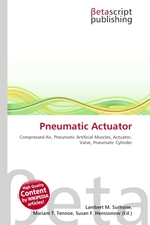Pneumatic Actuator
Lambert M. Surhone, Mariam T. Tennoe, Susan F. Henssonow
бумажная книга
High Quality Content by WIKIPEDIA articles! A pneumatic actuator converts energy (in the form of compressed air, typically) into motion. The motion can be rotary or linear, depending on the type of actuator. A Pneumatic actuator mainly consists of a piston, a cylinder, and valves or ports. The piston is covered by a diaphragm, or seal, which keeps the air in the upper portion of the cylinder, allowing air pressure to force the diaphragm downward, moving the piston underneath, which in turn moves the valve stem, which is linked to the internal parts of the actuator. Pneumatic actuators may only have one spot for a signal input, top or bottom, depending on action required. Valves require little pressure to operate and usually double or triple the input force. The larger the size of the piston, the larger the output pressure can be. Having a larger piston can also be good if air supply is low, allowing the same forces with less input. These pressures are large enough to crush object in the pipe. On 100 kPa input, you could lift a small car (upwards 1,000 lbs) easily, and this is only a basic, small pneumatic valve.
Данное издание не является оригинальным. Книга печатается по технологии принт-он-деманд после получения заказа.


